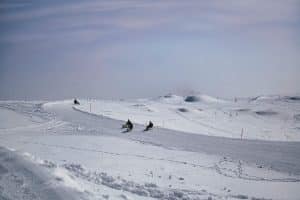Arctic Mobility: Inuit-Inspired Designs for -40°C Survival
The Arctic is known for its extreme weather conditions, with temperatures that can drop to -40°C during the winter season. Surviving in such harsh conditions requires a high level of adaptability and resilience, something that the Inuit people have mastered over thousands of years. The Inuit have developed unique designs and technologies that enable them to thrive in the Arctic’s freezing temperatures, and these designs have inspired modern Arctic mobility solutions that could save lives in extreme cold conditions.
The Inuit People: Masters of Arctic Survival
The Inuit are the indigenous people of the Canadian Arctic, Alaska, Greenland, and the Chukchi Peninsula in Russia. For thousands of years, they have lived in one of the harshest environments on the planet, where temperatures can plummet to -40°C and lower. Despite these conditions, the Inuit have managed to not only survive but also thrive in the Arctic, developing a deep understanding of the environment and the skills needed to survive in it.
One of the key aspects of Inuit life is mobility. In the past, the Inuit relied on dog sleds to travel and hunt across the vast expanses of ice and snow. These sleds were designed specifically for the Arctic environment, with light and flexible frames that allowed them to glide over the snow, and long runners that could easily traverse thin ice without breaking. The Inuit also made use of kayak-like boats called qajaqs or umiaks to navigate the frozen waters.
The Inspiration for Modern Arctic Mobility Designs
Modern Arctic mobility solutions have been heavily influenced by Inuit designs and technology. The Inuit’s mastery of dog sleds and boats has translated into innovations in snowmobiles, all-terrain vehicles (ATVs), and even rescue equipment.
Snowmobiles have become a popular mode of transportation in the Arctic, and the Inuit’s knowledge of lightweight and flexible frames has been incorporated into modern designs. The Inuit also used komatiks, or wooden sleds, to transport heavy loads over the snow. This design has influenced the development of modern transport sleds, which are used to transport vital supplies to remote Arctic communities.
The Inuit’s expertise in kayaks and umiaks has also translated into modern designs for Arctic rescue boats. These boats are designed to withstand extreme cold and harsh conditions, and can easily navigate through ice or rough waters.
Arctic Mobility: Saving Lives in Extreme Cold
The extreme cold of the Arctic can be deadly, making mobility solutions a matter of life and death in some situations. The Inuit’s deep understanding of their environment and their ability to create designs that can withstand such conditions has inspired modern Arctic mobility solutions that are vital for survival.
In the field of search and rescue, the Inuit’s traditional knowledge of animal behavior and weather patterns has been incorporated into modern search and rescue operations. These operations often involve working with local communities and using traditional Inuit knowledge to locate missing persons or aid in emergency situations.
Similarly, Inuit-inspired designs have been developed for emergency shelters and survival gear, such as parkas and mittens, that can withstand the harsh conditions of the Arctic and protect wearers from extreme cold.
Preserving Inuit Knowledge and Designs
As the world focuses on finding sustainable solutions for living in extreme environments, it is crucial to acknowledge and preserve the Inuit’s traditional knowledge and designs. The Inuit have developed unique and ingenious solutions that are not only effective but also sustainable, as they are tailored to the specific needs and challenges of the Arctic environment.
Efforts are being made to incorporate traditional Inuit knowledge and designs into modern technology, with the aim of bridging the gap between traditional and modern ways of life. This is not only beneficial for the Inuit community but can also have a significant impact on Arctic mobility solutions and the overall sustainability of the region.
Conclusion
The Inuit people have shown incredible resilience and adaptability in living and thriving in the extreme conditions of the Arctic. Their traditional knowledge and designs have inspired modern solutions for Arctic mobility, which are crucial for survival and preservation of life in this harsh environment. As we continue to face challenges in living sustainably and safely in extreme conditions, it is important to recognize and preserve the Inuit’s knowledge and designs, which hold valuable lessons for the future.










